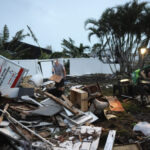A federal inspection report shows that officials at the Lucky Friday Mine in northern Idaho failed to conduct the second of two daily monitoring checks on the day a violent rock burst broke the pelvis of one miner and also injured six others.
The report is part of a collection of more than 300 pages of inspection documents the Spokesman-Review obtained through a Freedom of Information Act request.
In November, the Mine Safety and Health Administration ordered managers at the underground silver mine in Mullan to perform twice-daily monitoring of stress in rocks in mine shafts. The federal agency demanded the checks after a Nov. 16 rock burst that registered as a 2.8-magnitude quake on seismographs. That burst didn’t cause any injuries.
A second rock burst was reported Dec. 14, this time causing the injuries to seven miners.
A MSHA inspector reported that managers at the mine, operated by Hecla Mining Co., failed to conduct the second daily stress reading, according to documents obtained by the newspaper. The rock burst occurred later that evening.
“The company disregarded the safety of the miners by failing to do the required testing,” a federal inspector wrote in his report.
Hecla is appealing the inspector’s conclusion, and a company spokeswoman declined to comment.
According to the documents, mine superintendent Jeff Jordan told inspectors that he didn’t think rock stress readings could be taken because workers were installing a steel liner over stress gauges in that area. But the gauges contained extended wires so they could be read during the installation of the liner, which was intended to contain unstable rock, the documents said.
The inspection reports also offer more details about the December inspection that led to a yearlong shutdown of the Lucky Friday during a period of record silver prices. Federal inspectors closed the primary shaft on Jan. 6, citing safety concerns.
Hecla officials expect the mine to reopen in early 2013, after repairs are made to the shaft, which carries workers and ore into and out of the mine.
Among other findings detailed in the documents:
– Inspectors said loose concrete deposits in the mile-deep shaft were a hazard, with the potential to fall and injure or kill workers traveling in the shaft. The deposits were the result of leaking pipes that carry sand and cement into the mine. Some concrete chunks were as large as 2 feet by 3 feet.
– The weekly shaft inspections performed by Hecla employees were inadequate, federal inspectors said. The mine didn’t have systematic procedures for testing or inspecting the shaft or keeping up with shaft maintenance, the reports said.
– Several work areas didn’t have a secondary escape route. Inspectors said miners could be trapped underground if their only escape route was blocked by falling rock.
– Inspectors cited numerous areas where mesh fencing to contain unstable rock had holes torn in it. The Lucky Friday was cited more than 40 times for the same problem in the past two years, the reports said.
– In one area, inspectors snapped pictures of a portable toilet located directly underneath an overhead chute.
– About 70 pages of inspection documents were withheld because they’re related to an ongoing investigation of arson fires at the mine last summer.
Hecla plans to spend $50 million on capital projects at Lucky Friday over the next year, including $30 million for shaft repairs and upgrades. The Coeur D’Alene, Idaho, company’s goal is to surpass the federal safety requirements and operate as safely and efficiently as possible, Hecla spokeswoman Melanie Hennessey said in an interview last week.
Since a fatal accident at the mine in April 2011, Hecla has added geotechnical engineering staff at both the Lucky Friday Mine and the Greenscreek Mine in Alaska, she said. There was another fatal accident at Lucky Friday in November.
Was this article valuable?
Here are more articles you may enjoy.

 Plane Crashes into San Diego Neighborhood, Setting Homes And Vehicles on Fire
Plane Crashes into San Diego Neighborhood, Setting Homes And Vehicles on Fire  Brazil Sues EV Giant BYD Over ‘Slavery’ Conditions at Plant
Brazil Sues EV Giant BYD Over ‘Slavery’ Conditions at Plant  Will Workers’ Comp Benefit from ‘Most-Favored-Nation’ Drug Pricing?
Will Workers’ Comp Benefit from ‘Most-Favored-Nation’ Drug Pricing?  Here Comes Another Busy Atlantic Hurricane Season, But Will It Be as Crazy as 2024?
Here Comes Another Busy Atlantic Hurricane Season, But Will It Be as Crazy as 2024? 